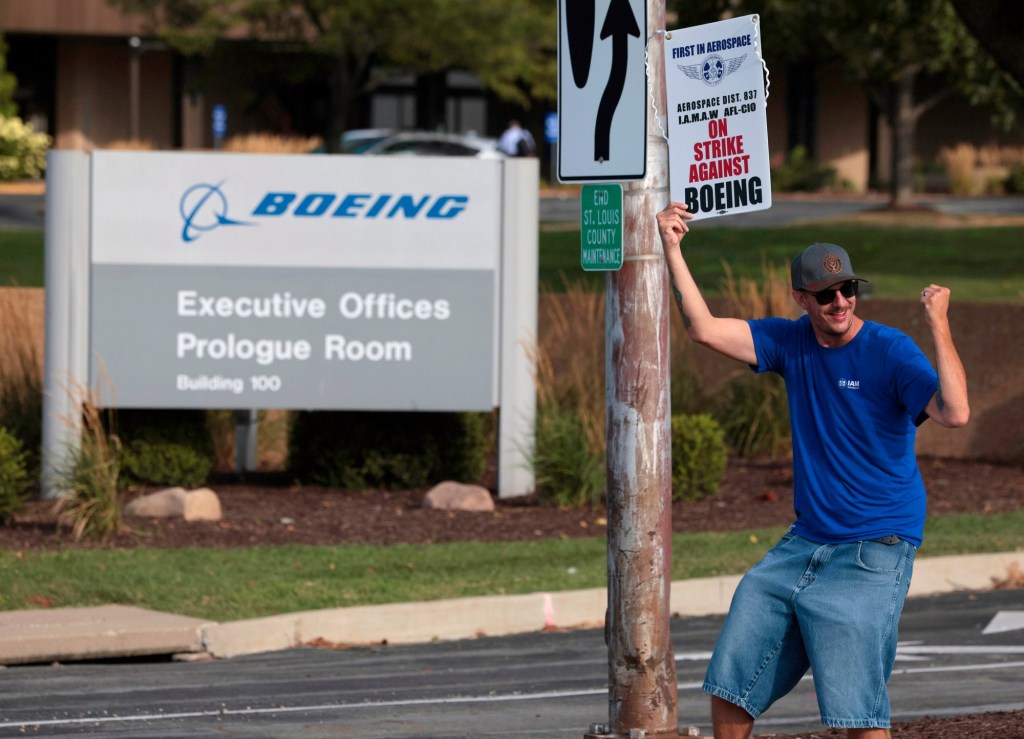By Julie Johnsson | Bloomberg
Boeing Co. Chief Executive Officer Kelly Ortberg’s campaign to rebuild the company culture from the factory floor on up is being put to the test by a rise in labor activism not seen in decades, as the US planemaker tries to end a standoff disrupting its fighter-jet assembly lines.
Ortberg has called for a return to civility, respect and openness as Boeing recovers from years of crisis, including whistleblower accounts of vindictive managers. The CEO stresses “working together” at every turn in his internal communiques.
Those ideals are running headlong into worker grievances over pay and pensions that were sacrificed last decade in long-term contracts that brought years of labor peace. Now that the planemaker is returning to shorter-term labor agreements and a near-continuous cycle of negotiations, it faces lingering ill will from its long-ago tactics.
The resentment is evident in the St. Louis area, where Boeing executives are slated to kick off talks on Monday with union leaders to try and end a three-week strike. The strife comes months after a crippling work stoppage by Boeing’s Seattle-area hourly workers, who had last gone on strike in 2008.
The unrest stretches across aerospace and aviation, as labor shortages embolden unionized workers. Airbus SE staff in the UK are poised to walk off the job, a strike by Air Canada’s flight attendants brought operations to a halt, while a three-week walkout earlier this year by machinists at RTX Corp. disrupted aircraft engine shipments. At GE Aerospace, machinists voted last week to authorize a strike at two facilities.
“Labor is having a moment all over,” said Ron Epstein, analyst with Bank of America Securities Inc. Unions have gained leverage since the Covid pandemic because there simply aren’t enough highly skilled mechanics to replace the baby boomers exiting the workforce. “It’s not like you can hire a bunch of people to go do this,” Epstein said.
Ortberg is facing his second major strike since joining Boeing a year ago, this time by a union that doesn’t have a history of activism. It’s only the third strike in a half century by factory workers at the defense hub, who’re represented by the International Association of Machinists and Aerospace Workers District 837, according to Scott Mikus, analyst with Melius Research.
The strife, which started with workers voting down contract terms endorsed by IAM leaders, comes ahead of Boeing’s upcoming negotiations with the union representing about 19,000 engineers, technicians and pilots.

It’s not unusual for the two sides in a labor standoff to take weeks before resuming contract talks. Each party would think carefully over how to reach a deal, especially after St. Louis workers rejected two previous management offers, said Leon Grunberg, a sociology professor who’s studied Boeing’s labor relations since the 1990s.
The four-year contract was the richest that Boeing has ever offered to the union. But for senior machinists there was a catch: they would get lump-sum bonuses instead of wage increases for two of those years. Workers at the top of the pay scale also faced several years without wage increases under an unpopular 2014 contract that locked in low pay raises as inflation skyrocketed.
“Veteran employees deserve better!” read one of the signs on a St. Louis picket line last week as Brian Bryant, president of the International Association of Machinists and Aerospace Workers, addressed striking workers. “8% + 0% + 0% + 4% equals BS.”
Like their counterparts in Seattle, older St. Louis union members are still feeling the fallout from contracts in 2014 that froze pensions amid worries management would shut down or move manufacturing out of the region.
That wasn’t an idle threat under former Boeing CEO Jim McNerney, particularly since the company held power over its unions last decade — and used it. On McNerney’s watch, Boeing shifted production of the company’s marquee 787 Dreamliner aircraft to union-averse South Carolina after the 2008 strike by Seattle factory workers.
“They’ve been reaping the whirlwind ever since,” said Thomas Kohler, a concurrent professor of law and philosophy with Boston College’s law school. “It’s unfortunate that put the unions in a very wary position of looking at management.”
The current strike hasn’t had anywhere near the same scope or financial punch as the walkout last year by the 33,000 members of Boeing’s largest union that shut down factories from Washington to California for two months. Ortberg had just been hired to turn around a Boeing reeling from investigations sparked by a near-catastrophe in early 2024.
In St. Louis, all of Boeing’s sites remain open, with employees who aren’t striking continuing to support customers. IAM District 837 accounts for about 20% of the company’s 16,000 employees in the region, Boeing said.
Still, an extended stoppage might hurt Boeing’s efforts to break a pattern of cost overruns and delays at the defense unit. In a July filing, the manufacturer cautioned that disruptions could mean “our financial position, results of operations and cash flows will be adversely impacted.”
“I would’ve thought after the strike in Seattle, they would’ve done everything they could to mitigate it,” Epstein said. “But they didn’t.”



